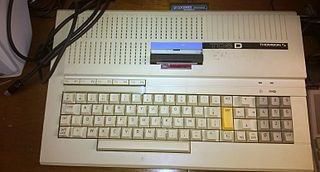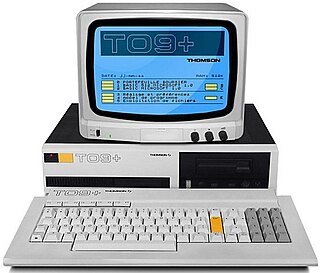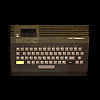
The Commodore 64, also known as the C64, is an 8-bit home computer introduced in January 1982 by Commodore International. It has been listed in the Guinness World Records as the highest-selling single computer model of all time, with independent estimates placing the number sold between 12.5 and 17 million units. Volume production started in early 1982, marketing in August for US$595. Preceded by the VIC-20 and Commodore PET, the C64 took its name from its 64 kilobytes(65,536 bytes) of RAM. With support for multicolor sprites and a custom chip for waveform generation, the C64 could create superior visuals and audio compared to systems without such custom hardware.
The Sinclair QL is a personal computer launched by Sinclair Research in 1984, as an upper-end counterpart to the ZX Spectrum.

The ZX Spectrum is an 8-bit home computer developed and marketed by Sinclair Research. Considered one of the most influential computers ever made, it is also one of the best-selling British computers ever, with over five million units sold. It was released in the United Kingdom on 23 April 1982, and around the world in the following years, most notably in Europe, the United States, and Eastern Bloc countries.

The Amstrad PCW series is a range of personal computers produced by British company Amstrad from 1985 to 1998, and also sold under licence in Europe as the "Joyce" by the German electronics company Schneider in the early years of the series' life. The PCW, short for Personal Computer Word-processor, was targeted at the word processing and home office markets. When it was launched the cost of a PCW system was under 25% of the cost of almost all IBM-compatible PC systems in the UK, and as a result the machine was very popular both in the UK and in Europe, persuading many technophobes to venture into using computers. The series is reported to have sold 8 million units. However the last two models, introduced in the mid-1990s, were commercial failures, being squeezed out of the market by the falling prices, greater capabilities and wider range of software for IBM-compatible PCs.

The Matra & Hachette Ordinateur Alice is a home computer sold in France beginning in 1983. It was a clone of the TRS-80 MC-10, produced through a collaboration between Matra and Hachette in France and Tandy Corporation in the United States.

The ThomsonMO5 is a home computer introduced in France in June 1984 to compete against systems such as the ZX Spectrum and Commodore 64. It had a release price of 2390 FF.

The Thomson EF936x series is a type of Graphic Display Processor (GDP) by Thomson-EFCIS. The chip could draw at 1 million pixels per second, which was relatively advanced for the time of its release.

The VTech CreatiVision is a hybrid computer and home video game console introduced by VTech in 1981 and released in 1982 during the second generation of video game consoles. It cost $295 Australian Dollars in Australia. The hybrid unit was similar in concept to computers such as the APF Imagination Machine, the older VideoBrain Family Computer, and to a lesser extent the Intellivision game console and Coleco Adam computer, all of which anticipated the trend of video game consoles becoming more like low-end computers. It was discontinued in 1986.

The FM-7 is a home computer created by Fujitsu. It was first released in 1982 and was sold in Japan and Spain. It is a stripped-down version of Fujitsu's earlier FM-8 computer, and during development it was referred to as the "FM-8 Jr.".

Home computers were a class of microcomputers that entered the market in 1977 and became common during the 1980s. They were marketed to consumers as affordable and accessible computers that, for the first time, were intended for the use of a single, non-technical user. These computers were a distinct market segment that typically cost much less than business, scientific, or engineering-oriented computers of the time, such as those running CP/M or the IBM PC, and were generally less powerful in terms of memory and expandability. However, a home computer often had better graphics and sound than contemporary business computers. Their most common uses were word processing, playing video games, and programming.

The Thomson TO7, also called Thomson 9000 is a home computer introduced by Thomson SA in November 1982, with an original retail price of 3750 FF. By 1983 over 40000 units were produced. About 84 games were released for the TO7.

The ThomsonMO6 was a Motorola 6809E-based computer introduced in France in 1986. It was intended as the successor to the Thomson MO5 and featured 128 KB of RAM, a 40 × 25 text display, and a new built-in Microsoft BASIC interpreter. It retained compatibility with its predecessor, while incorporating the same technology as the TO8.

The Thomson TO8 is a home computer introduced by French company Thomson SA in 1986, with a cost of 2,990 FF. It replaces its predecessor, the Thomson TO7/70, while remaining essentially compatible.

The VG5000μ is a computer created by Philips in 1984. It was manufactured in Le Mans by Radiotechnique (RTS) and marketed under the Philips, Radiola and Schneider brands.

In the 1980s the French Thomson company produced a range of 8-bit computers based on the 6809E CPU.
BASIC 1.0 is the standard BASIC language for Thomson computers, which is the reference for the entire range. This is an implementation of Microsoft BASIC (BASIC-69). It was used to introduce children from France to programming in the 1980s. Three languages were mainly taught: LSE, BASIC and LOGO. School textbooks programs were given in BASIC 1.0 for Thomson and sometimes in ExelBasic for the Exelvision EXL 100.

The Thomson TO9+ is a home computer introduced by French company Thomson SA in 1986. It kept the professional look of the Thomson TO9 by using a separate keyboard.
The Thomson TO16 or Thomson TO16PC is a PC compatible personal computer introduced by French company Thomson SA in 1987, with prices ranging from 9000 to 16000 FF depending on the version.
The Computing for All plan was a French government plan to introduce computers to the country's 11 million pupils. A second goal was to support national industry. It followed several introductory computer science programs in schools since 1971. The IPT plan was presented to the press on January 25, 1985 by Laurent Fabius, Prime Minister at the time. It aimed to set up, from the start of that school year, more than 120,000 machines in 50,000 schools and to train 110,000 teachers. Its estimated cost was 1.8 billion francs, including 1.5 billion for equipment. The plan was abandoned in 1989.

L'Aigle d'Or is a 1984 French action video game by Loriciels.

















